

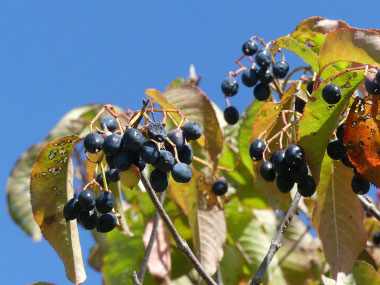
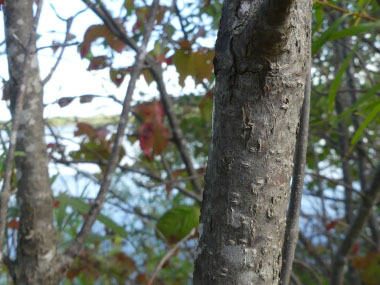
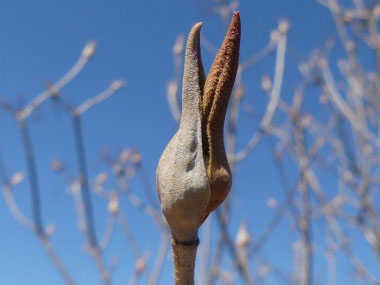
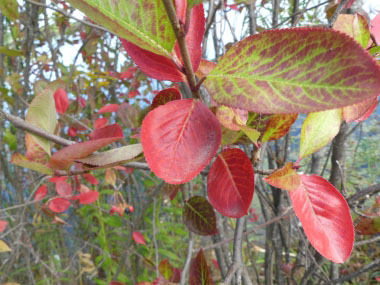
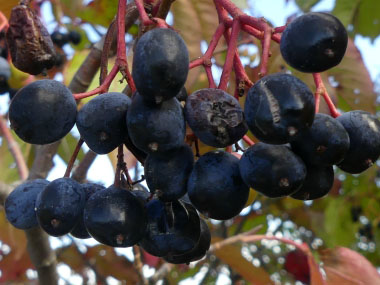
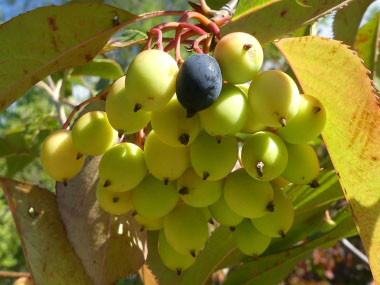
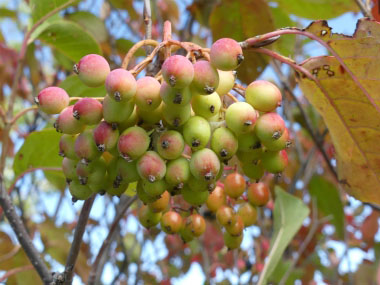
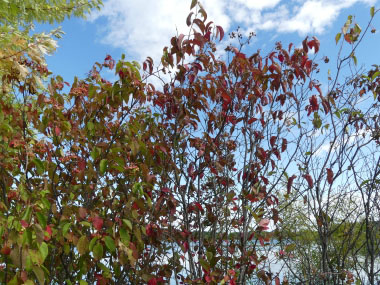
To support our efforts please browse our store (books with medicinal info, etc.).
Nannyberry is a magnificent yet underutilised native shrub with many qualities; large clusters of creamy white flowers in spring, dark green foliage throughout the summer, showy dark blue fruit in fall and leaves that have an attractive fall colour. It typically grows upright and spreads, and can be categorized as a small tree or as a shrub. Nannyberry is in the muskroot (Adoxaceae) family. The genus Viburnum covers a large number of shrubs and the name is an old Latin name for one particular member of the genus. The species, lentago, comes from another Latin word meaning 'flexible' and was assigned by Linnaeus as the twigs are very tough and flexible.
Trunk/Bark
The bark is dark brown (ish) with a blocky appearance. It has raised lenticels that somewhat resemble puffed rice. Older bark becomes dark gray with deeply checkered furrows. Main stems are typically multiple from base, often forming think colonies from root suckers.
Branches/Twigs
Twigs are grayish brown, slender and straight, the buds pinkish-brown, slender and up to 2 cm ( ½”) long with flower buds appearing swollen at the base.
Height
Nannyberry grows anywhere from 3 to 7 metres (10 to 25') tall depending on its habitat. It can spread to 4.5 metres (15').
Leaves/Needles
Leaves occur opposite, are long (about 5 to 7 cm), oval-shaped with crowed, short, sharp teeth, wavy margins and a winged leafstalk. They are glossy dark green with a lighter underside changing to reddish-purple in the autumn.
Flowers
Nannyberry flowers are small, creamy white, and occur in clusters ( up to ) 11 cm (4 1/2”) flat-topped to slightly domed occurring on at tips of (minimum) one-year old branches. Individual flowers are about 1 cm (¼”) across, bell to saucer-shaped with 5 rounded lobes. In the centre is a single, short style and 5 long, yellow-tipped stamens that extend far beyond the mouth of the floral tube. The calyx around the base of the flower has a short tube and 5 small, triangular lobes. Flower stalks are hairless and green to red. Flowers bloom May to June.
Fruit
Berry-like fruit (drupes) starting out yellow and red and maturing to dark blue or black.
Habitat
Nannyberry grows in a variety of habitats from moist soils; hardwood forest openings, swamps, fens, wet meadows, lake shores, river banks. It grows in part and full sun. The preferred habitat is moist soil in low woods or near water, but it can tolerate drier sites.
Edible Parts
Berries are edible raw or used in a variety of ways in beverages or baked goods. The bark has been used in herbal preparations.
Other Name
Sheepberry.
Recipes
Winter Survival Food Handbook

PDF Plant Magazines
Types of Wild Food
Geographic Zones Seasons
Disclaimer
EdibleWildFood.com is informational in nature. While we strive to be 100% accurate, it is solely up to the reader to ensure proper plant identification. Some wild plants are poisonous or can have serious adverse health effects.
We are not health professionals, medical doctors, nor are we nutritionists. It is up to the reader to verify nutritional information and health benefits with qualified professionals for all edible plants listed in this web site. Please click here for more information.
Why Edible Wild Food?
- Food costs are rising
- Free, wild food is readily abundant
- Wild food adds nutrition to your diet
- Wild food can help treat various medical conditions





